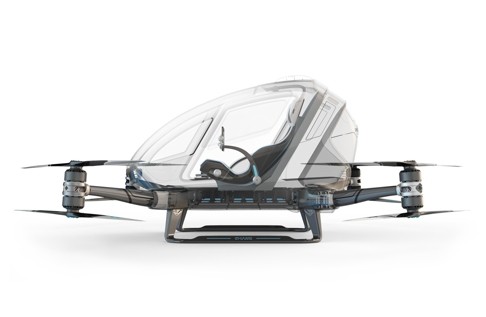
What we learned about China tech at the Consumer Electronics Show 2016
Chinese companies made up more than a quarter of exhibitors at the international trade fair, exhibiting everything from a passenger drone to robots, virtual reality sets ... and an allegedly patent-infringing hoverboard
A Batmobile-like electric car, a yogi robot and a passenger drone – these were just some of the innovative products Chinese companies exhibited at the annual Consumer Electronics Show (CES), where they are increasingly making their presence felt.
The four-day trade fair, held in Las Vegas this month, saw a big rise in Chinese exhibitors. According to tech news site ifanr.com, more than 1,100 Chinese companies exhibited at CES 2016, double the number last year and accounting for 27 per cent of the exhibitors this year.
Drone maker Ehang showed the world’s first passenger drone. The Ehang 184 can carry a single passenger weighing up to 100kg at a speed of 100km/h for a23 minutes, according to the company.

Like helicopters, the Ehang 184 lands vertically, eliminating the need for runways. Its simple tablet controls make it easy to operate and users will not require a pilot’s licence to fly one. However, laws may need changing before drone enthusiasts can pilot the Ehang 184 themselves.
Derrick Xiong, co-founder of Ehang, said the drone represents an entirely new category of technology and is in “uncharted waters” as a means of transport. Xiong said Ehang was working closely with governments to develop regulations for the industry.

Meanwhile, Chinese entertainment portal LeTV has partnered with electric-car start-up Faraday Future, which unveiled its sleek, Batmobile-like FFZERO1 electric vehicle concept at the tech show.
Faraday Future says the electric cars it plans to produce will be modular, allowing for drivers to build their own car or swap out parts easily.
Faraday Future has been widely tipped as a potential rival to the current leader in the market for electric vehicles, Tesla. California-based Tesla, founded by billionaire Elon Musk, has already launched several popular models of electric cars, including the Tesla Model S and X.
As Tesla has done, Faraday plans to spend heavily on production facilities; in November it said it would invest US$1 billion in a factory in the US. Tesla has poured an estimated US$5 billion into building a factory in the US with the capacity to produce 25 gigawatt-hours (GWh) a year of lithium-ion batteries.
A slew of other Chinese consumer products were unveiled at CES, including UBTECH’s Alpha 2 robot, a new Huawei smartphone and virtual-reality headsets.
The Alpha 2 is an intelligent robot that helps users with reading and replying to emails, reminders and setting alarms. The robot, priced at US$1,299, boasts 20 joints, allowing it to replicate human motion and making it “as flexible as a yogi”, according to UBTECH. Company photos and videos show the Alpha 2 striking yoga poses and dancing to the latest pop hits.

Smartphone maker Huawei introduced its latest flagship model, the Huawei Mate 8, in Las Vegas. The Mate 8 phablet has a 6-inch display and runs on Huawei’s Kirin 950 processor. The phone sports a full-metal body and its 4,000 mAh battery also guarantees a longer battery life.

Meanwhile, what would a tech show be without virtual reality - widely predicted to take off this year?
China-based start-up ANTVR presented two virtual-reality headsets at CES; while one needs to be hooked up to a PC, the other, lower-spec headset is designed to work with Lenovo smartphones. Simply slide your Lenovo phone into the headset to serve as a display and you’re ready to go. In contrast, market rivals like the Oculus Rift and upcoming HTC Vive need to work in tandem with a computer.

And what would a tech show be without a Chinese patent infringement dispute? US federal marshals raided Chinese exhibitor Changzhou First International Trade’s booth on suspicion the one-wheeled hoverboard it had on display infringed patents. Marshals confiscated display models and removed posters and fliers promoting the hoverboard.

Future Motion, a US-based startup that specialises in personal transportation devices, accused Changzhou First International Trade of violating patents for its Onewheel hoverboard.
The Chinese company’s product looked remarkably similar to the Onewheel, with Future Motion’s chief engineer Kyle Doerksen describing it as “clearly a knock-off”.
Doerksen said cease-and-desist letters sent to Changzhou First International Trade requesting it halt sales of the “Trotter” hoverboard had been ignored. When Doerksen confronted the Chinese company at CES and was spurned, Future Motion decided to take legal action, resulting in the marshals’ raid.

While there was a surge of interest in CES from Chinese manufacturers this year, this trend could change with the announcement by Chinese e-commerce juggernaut Alibaba that it will stage its own consumer electronics show in Shenzhen this year, rivalling CES.
Alibaba has teamed up with German group Internationale Funkausstellung Berlin (IFB) to organise the “Consumer Electronics China” trade show, which will run from April 20 to 22. The company is looking to sell more consumer electronics on its e-commerce platforms, such as Tmall.

